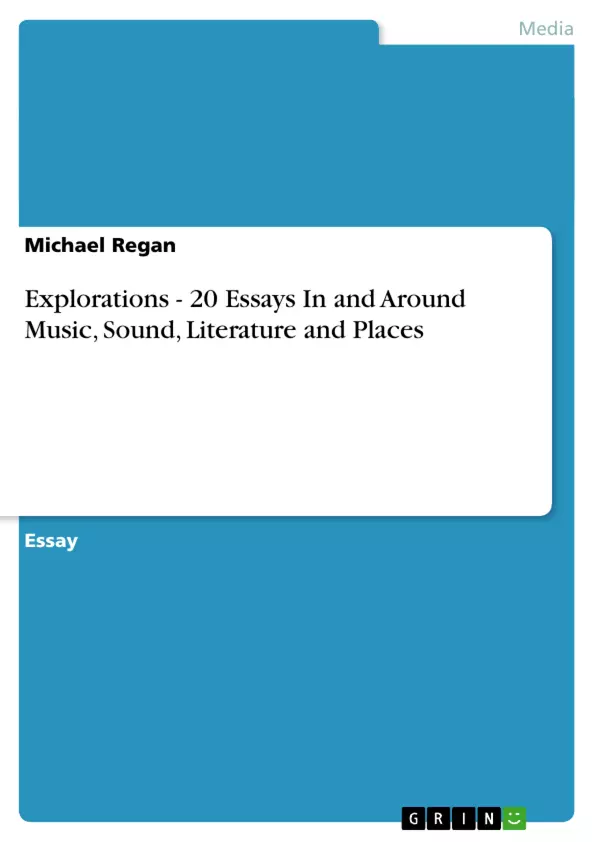The essays are divided into three sections: those featuring some of the composers whose music has been of particular significance to me; then a group of pieces on compositional matters including aspects of style and form such as minimalism, improvisation and repeats; and finally a miscellaneous group on diverse topics including education, the sonic environment and the meaning of music and art in general.
The final essay entitled “Explorations” is a summary of those many enthusiasms that I have indulged in over the years, but actually, all the essays are attempts at sharing my love of music, sound, literature and places without in any way pretending to be authoritative. In fact I discovered that the more I try to write about a subject dear to me, the more aware I am of not knowing nearly enough about it. Therefore I plead guilty if it is levelled at these pages that enthusiasm outpaces concrete knowledge, although I would hope that it could not be said of them, as John Butler Yeats once said of his more famous son’s opinions, that they are drawn “from the depths of (my) ignorance”. I have tried not to theorise, feeling that there are altogether too many theories in the world. Some of these items celebrate, some explore. They are simply the results of numerous interests which I just do not want to keep to myself any longer. Whether this is wise or not - let the reader judge. The least I can hope is that I might stimulate others to explore some of the subjects which have inspired and indeed kept me going (mentally that is) through six decades.
Inhaltsverzeichnis (Table of Contents)
- A Note on Palestrina
- Hesse, Busoni, Mozart & Immortality
Zielsetzung und Themenschwerpunkte (Objectives and Key Themes)
This collection of essays aims to share the author's love of music, sound, literature, and places, without claiming to be authoritative. It explores the author's personal journey through various musical and artistic interests, focusing on the enduring power of great works of art and the difficulty of judging modern art in a context of diverse styles.
- The enduring quality of great works of art and the concept of "immortality" in the context of artistic legacy.
- The role of rules and restrictions in artistic expression, particularly in the context of Renaissance music and the works of Palestrina.
- The nature of originality and stylistic innovation in music, with Mozart as a key example of a composer who both adhered to and challenged conventional musical norms.
- The challenges of assessing artistic value in a modern context characterized by diverse and often idiosyncratic styles.
- The role of personal expression and the search for individual artistic languages in contemporary art.
Zusammenfassung der Kapitel (Chapter Summaries)
A Note on Palestrina
This essay challenges the notion that the music of Palestrina and the Renaissance period is uninteresting due to its adherence to rules. The author argues that the restrictions imposed on melodic shape and harmonic style were not merely musical constraints but rather served the purpose of expressing profound religious doctrines. The essay highlights the beauty of Palestrina's music, particularly when performed in a resonant space, and argues that judging it by contemporary standards is anachronistic. The author emphasizes the importance of listening to Palestrina with an open mind, free from preconceptions about his work.Hesse, Busoni, Mozart & Immortality
This essay examines the concept of "immortality" in relation to great works of art. The author draws on Herman Hesse's notion of "immortals" – artists whose works transcend time and continue to resonate with each generation. The essay explores the nature of artistic genius, arguing that it is not simply about inventing new things but rather about combining existing elements in ways that convey depth of expression. The author contrasts the work of Mozart with that of less renowned composers, highlighting Mozart's ability to both adhere to and break musical conventions in order to achieve a unique and lasting impact. The essay concludes by questioning whether there are any "immortals" in the modern age, considering the prevalence of diverse and often idiosyncratic styles. The author suggests that it is too early to say whether any contemporary artists will attain the same lasting significance as their predecessors.
Schlüsselwörter (Keywords)
This preview focuses on themes related to artistic genius, musical expression, stylistic innovation, and the perception of art across historical periods. Key terms include: "immortality", "rules" in art, "originality", "stylistic restrictions", "depth of expression", "musical conventions", "modern art", and "idiosyncratic styles".
- Arbeit zitieren
- Michael Regan (Autor:in), 2012, Explorations - 20 Essays In and Around Music, Sound, Literature and Places , München, GRIN Verlag, https://www.grin.com/document/202807



